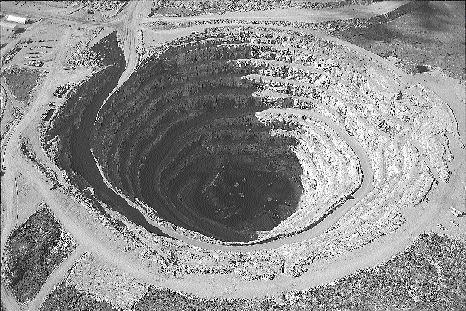Development of the Panda underground deposit was contemplated in the original environmental assessment and mine plan. Subsequent engineering work and test mining determined that underground recovery of the lower portions of the Panda kimberlite would be economic.
BHP Billiton went underground on the adjacent Koala North pipe in 2002, as a test, to determine the types of equipment, materials and mining processes that would work best in Arctic permafrost conditions.
Panda is one of eight kimberlite pipes that form the basis of the Ekati mine plan. In June 2003, after almost five years of operation, the original open pit at Panda reached the limits of its economic depth. Ekati has since replaced the Panda ore with production from the lower-value Misery open-pit satellite operation, 30 km away, and more recently the Koala open pit, adjacent to the main camp facilities.
Output in the first three months of 2004 totalled almost 1.27 million carats of rough diamonds — a 40% decline from the previous quarter but in line with the corresponding period of 2003. Ekati treated 1.05 million tonnes of kimberlite ore grading 1.21 carats per tonne in the March 2004 quarter. The spike in production, quarter to quarter, was attributed to a high-grade pocket of ore in the Koala pit, which has since been mined out.
For the first nine months of fiscal 2004, Ekati produced more than 5.3 million carats from 3.2 million tonnes of kimberlite ore averaging 1.65 carats per tonne. In the corresponding period of 2003, the mine produced 3.8 million carats from 3.1 million tonnes averaging 1.21 carats per tonne.
For fiscal 2003, Ekati churned out 5.4 million carats of rough diamonds — 19% more than in 2002.
The Panda underground project is a 2,600-tonne-per-day sub-level retreat mine, which will deliver 4.7 million carats of high-value diamonds over six years. Initial production is expected in early 2005, leading to full production in early 2006, after the conveying system is commissioned. Kimberlite ore reserves for the underground project are estimated at 4.6 million tonnes.
At June 30, 2003, Ekati has overall reserves of 47.7 million tonnes grading 0.8 carat per tonne, equivalent to 36.6 million recoverable carats, based on a 2-mm bottom-stone cutoff size. Measured, indicated and inferred kimberlite resources in the central core zone stood at 88.5 million tonnes grading 1 carat per tonne, or 88.5 million carats, using a 1-mm size cutoff. In the outlying Buffer zone claims, kimberlite resources total 39.4 million tonnes grading 2.1 carats per tonne, for an additional 82.7 million carats.
“The production grades and diamond quality at Ekati are declining as the mine ages,” says Marcus Randolph, BHP Billiton’s president of diamonds and specialty products. “The Panda development will partially arrest this decline during its six-year life by supplying about twenty per cent of the mine feed to the plant while producing about forty per cent of the diamond output by value. The underground material will deliver margins three times greater than the material it displaces.”
Ekati is operating at an average throughput rate of 12,000 tonnes per day.
The US$182 million investment in underground mining at Panda provides for the following:
— modification to existing surface facilities that were established for the Koala North underground project, including surface maintenance workshops, offices and a dry;
— purchase of mining equipment (drills, loaders, trucks and utility equipment);
— access to the underground portion of the Panda pipe from the existing Koala North underground ramp;
— initial development of the Panda underground ramp and production levels;
— construction of a portal adjacent to the process plant and the development of a 3.2-km-long conveyor ramp to Panda underground;
— a conveying and crushing system;
— a mine ventilation system, including three large-diameter raise bored shafts and an air-heating system;
— underground infrastructure, including a dewatering system, maintenance workshop, electrical distribution and communication systems.
BHP Billiton is the operator and 80%-owner of the Ekati mine. The remainder is shared between geologists Charles Fipke and Stewart Blusson.


Be the first to comment on "BHP Billiton approves Panda underground mine at Ekati"